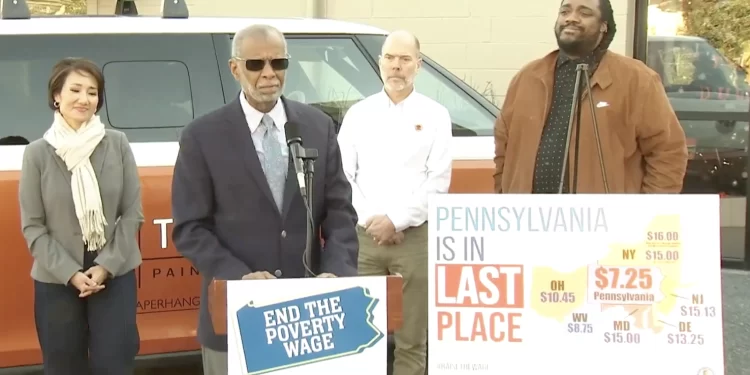By Christina Lengyel | The Center Square
(The Center Square) – Twenty-one states across the US are raising the minimum wage in 2025. Pennsylvania Democrats would like to see the commonwealth soon join their ranks.
Sen. Art Haywood, D-Philadelphia, joined legislators and representatives from the business community in Lancaster to draw attention to the state’s flagging $7.25 minimum.
“We are here on New Year’s Eve for a reason,” said Sen.-Elect Patty Kim, D-Harrisburg, citing the increases that will take effect tomorrow in other states. “Unfortunately, Pennsylvania has not made the list”
Kim was among leaders who saw a bill raising the wage through the House last year. The effort ended when it reached the Republican-controlled Senate.
“Tomorrow, so many Americans are going to see a raise in their pay,” said Haywood. “When is that tomorrow for Pennsylvanians?”
Haywood noted that he has seen the same push every year in the near decade he has spent in office. For him, the blame lies squarely at the feet of Republican legislators who have repeatedly denied the call to catch up with other states.
For their part, Republicans note that independent estimates show raising the wage will cut jobs, having the opposite effect than intended.
The minimum has not been raised since the last federal increase in 2009. Pennsylvania is among just 20 states who still adhere to the federal minimum.
Neighboring New Jersey, New York, Maryland, and Delaware will all have minimum wages more than double that of Pennsylvania at or above $15. West Virginia sits at $8.75 and Ohio $10.70.
Adjusted for inflation, the 2009 $7.25 rate would be the equivalent of $10.28 today. Full-time employment at the current rate earns workers just over $15,000 annually, which is less than half the poverty line for individuals.
For fair wage advocates, the issue largely comes down to dignity and seeing equal pay for workers across state borders.
“It’s time for us to say that a Pennsylvanian is worth a certain amount. If you want the labor of a Pennsylvanian, and you should, their labor is worth at least $15 an hour,” said Rep. Ismail Smith Wade-El, D-Lancaster.
Business owner Pete Barber of Two Dudes Painting spoke to his own experience. He says that while the wages he pays his employees are a reflection of his moral beliefs, they’re also good for business.
“We’ve become an employer of choice within our industry because people know that we pay people well,” he said. “People know that they have benefits here. People know that they can thrive, that they can take care of their families, that they can take care of their kids.”
Opponents of a higher wage say that the increase will force businesses to cut jobs, with some estimating that the state could lose up to 5,000 jobs if the wage was even at $12. In response, advocates point to thriving businesses like Barber’s.
While the number of workers being paid at or below the minimum wage has seen a downward trend, advocates want to see all workers treated equally and employers held to the same standards, especially given that those who would be most impacted by a raise are women, people of color, and senior citizens – groups that are already in vulnerable socioeconomic positions.
Federal data shows just under 64,000 residents make $7.25 or less an hour and nearly three-quarters of those include tipped workers. Another 418,000 make up to $12 an hour, and 510,000 earn between $12 and $15 per hour.
Further, the number of “at-or-below” workers declined more than 40% between 2017 and 2022 – largely due to the pandemic-induced labor shortage.
The Keystone Research Center said one in four workers would benefit from a $15 minimum wage, which would boost annual earnings by an average of $4,300.
Most of those workers, according to the center, include women between the ages of 20 and 39 and people of color, while 18% are over the age of 55.
In 2019, Senate Republicans have proposed increasing the rate to $9.50, though their colleagues in the lower chamber did not get on board.
In the years since, Republicans in the upper chamber have balked at the figures proposed by their Democratic colleagues, which often tie the wage to the cost of living, allowing for baked-in incremental raises over time. During the last legislative push, Senate Majority Leader Joe Pittman, R-Indiana, said “$15 an hour is not a practical number.”
Not all rank-and-file Republicans agreed, however.
In 2023, Sen. Dan Laughlin, R-Erie, said he wants to raise the rate from $7.25 to $15 per hour by 2026 – and bind it to inflation “thereafter.”
Laughlin became the first Republican senator to cross the aisle in support of a $15 minimum wage, though he’s defected on the issue before. In 2021, he advocated for a $10 minimum wage that was ultimately too modest for Democrats, The Center Square previously reported.
For Haywood, it’s a “moral imperative, not just an economic one.” Asked whether he could see a compromise below




